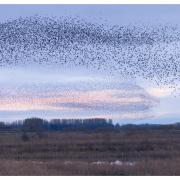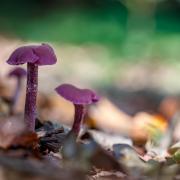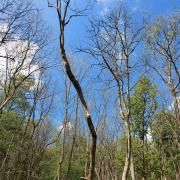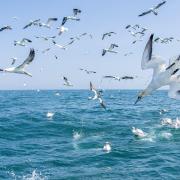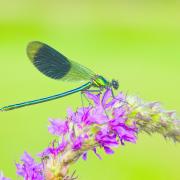Dormice are vulnerable to extinction and a rare sight in the Yorkshire Dales. Tony Greenway finds out about a programme to increase their numbers and looks at the the risk to other species

I’m no David Attenborough, but even I know that dormice are lazy, lethargic, slow-moving creatures who live in teapots.
Aren’t they? Er, no, insists Ian Court, wildlife conservation officer at the Yorkshire Dales National Park Authority. In fact, we can rule out the teapots thing pretty much immediately (blame Lewis Carroll’s Alice in Wonderland for that one). And as for lethargic and slow-moving – you’ve got to be joking. ‘If you’d seen me today trying to catch one, you’d know that description couldn’t be further from the truth,’ he says.
In fact, dormice are, as Court will tell you, rather fast on their feet. True, they do go into ‘topor’, which is a deep sleep in their active period that shuts down their body (and presumably why – Lewis Carroll aside – they have a reputation for being a bit dozy). But when they’re lively, boy, are they lively. ‘They are so fast and agile,’ says Court. ‘They’re amazing creatures.’
There are, then, a few myths to bust about dormice. Despite their name, dormice are not mice at all: they’re a small rodent with a furry tail, rather than a hairless one, and they hibernate. They’re nocturnal, too – so they have big eyes and long whiskers for navigating in the dark – are slow breeders and have a relatively long life expectancy of around four to five years. Oh, and they are ridiculously cute.

Unfortunately, they are also rare and vulnerable to extinction, making them one of Britain’s most threatened mammals. This is partly because they are arboreal, which means they prefer walking along tree branches and hedgerows rather than across the ground, and the network of hedgerows they use to get from woodland to woodland, has slowly eroded and declined over the years.
Dormice thrived when hazel trees in woodlands were regularly cut back but now, because of changes to traditional countryside management practices, their numbers have been decreasing in the Yorkshire Dales. ‘We live in a highly fragmented country which isn’t great for a small rodent that needs to climb around in the tree and shrub canopies to expand its territory,’ explains Ian White, dormouse officer with wildlife charity People’s Trust for Endangered Species (PTES).
Which is why this summer PTES released 20 breeding pairs of rare hazel dormice (so called because they like to nibble on a nice bit of hazel in the autumn before bedding down for their winter sleep) into a woodland location near Aysgarth in the Yorkshire Dales National Park.
‘The dormice were captive bred at Paignton Zoo and London Zoo and underwent a strict quarantine procedure to ensure they had no illnesses before they were released,’ says Court. ‘They were then put into release cages in the woodland for 10 days and we went out weighing them and checking they were OK. We also opened a door in the cage so they’ll hopefully start exploring the woodland around them.’

All the animals are microchipped and will still be fed and watered for a while by Court and his team; although the hope is that gradually (maybe even by the time you read this) the dormice will be able to fend for themselves. ‘A lot of work has gone on behind the scenes to enable us to re-introduce the dormice to the Dales,’ says Court. ‘One of the key things is working with farmers and landowners to make positive change. For example, we worked very closely with the Bolton Estate, who own a lot of the woodland and have been extremely supportive of the re-introduction project.’
It would be awful if the dormice population became extinct say both Court and White and, with dwindling numbers, it could happen. Yet there is reason to be optimistic that re-introduction programmes actually work. There are now two populations of dormice in the Dales thanks to a similar re-introduction of the species in 2008 in Freeholders’ Wood, near Aysgarth. This was a big success and, in 2014, the national park authority recorded its highest ever numbers of dormice.
‘The great thing about dormice is that are very cute,’ says White. ‘People want to see them and work with them. And they’re not the only ones who like a managed woodland habitat so do butterflies, birds and bats.’ Which means a project like this doesn’t just help dormice. It helps a range of wildlife. And that’s good news because it’s not just dormice that are vulnerable species in the Dales.
Take red squirrels. ‘These are under threat from, primarily, an incursion from non–native grey squirrels,’ says Court. ‘There are several very keen local groups that work on squirrel conservation. We’ve been doing a lot of monitoring which shows that we have a strong population of red squirrels in the Dales – they’re holding their own.’

Skylarks and curlews are also on the ‘under threat’ list. ‘Skylarks are a national priority species which do reasonably well on the moorland fringe of the Dales,’ says Ian. ‘The curlew populations in the UK are of international importance. In the Dales, our monitoring work appears to show that their population is stable, although the sample sizes are quite small. The classic habitat for curlews in the Dales is the heather moorland fringe and the hay meadows and pastures. If we didn’t have them displaying here, the Dales wouldn’t be the same. They’re an intrinsic part of the landscape.’
Black grouse numbers in the Dales – another moorland edge species – are also stable, says Court but there is concern about the population of yellow wagtails. ‘This is a species which nests in hay meadows, in the Dales at least,’ says Court. ‘Over the years we’ve done a lot of work with local farmers in areas where yellow wagtails have been nesting. It’s a little early to say what their numbers are at present as the results aren’t in yet and it’s the first time we’ve surveyed them for a number of years.’
But back to the dormice and a fact this time, not a myth. If you see a dormouse nesting box don’t disturb it – it’s against the law. ‘They’re a highly protected animal,’ says White. ‘So it’s illegal to disturb them or their nesting sites. Of course, as soon as we (at PTES or the national park authority) check a dormouse box, we’re potentially disturbing its resting place so we need to be licensed by Natural England.’ And they are experts at handling these delicate creatures and you are not.
The best way to help dormice or any endangered natural species in the Dales is to visit the area. ‘We want people to come to the Dales to enjoy the landscape and the wildlife,’ says Court. ‘Hopefully that will drive the management work under way here.’













